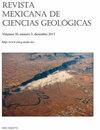墨西哥北部科阿韦拉Piedritas遗址中coniian - campanian海相沉积物中Xiphactinus (Teleostei, Ichthyodectiformes)的存在
IF 0.5
4区 地球科学
Q4 GEOSCIENCES, MULTIDISCIPLINARY
Revista Mexicana De Ciencias Geologicas
Pub Date : 2022-07-26
DOI:10.22201/cgeo.20072902e.2022.2.1684
引用次数: 1
摘要
据报道,在这里发现了墨西哥第一个属于水豚的化石标本。该标本是在科阿韦拉以北奥坎波市同名ejido的Pieditas遗址的奥斯汀群的科尼亚纪-坎帕尼亚期海洋沉积物中发现的。尽管该标本非常零碎,部分通过骨骼的印模或模具保存,并且只显示了头部、操纵管系列和胸鳍的部分,但它有足够的解剖特征,可以确定其特定的分类。在这些诊断特征中,这块化石有一块发育良好的腭咽骨、一个发育良好的枕上嵴、一个比其他骨头靠前的上颌骨和一个非常坚固的腭关节头。特别是,这块化石展示了Xiphactinus属的两个独特特征,一排圆锥形牙齿,大小不规则,分布在上颌骨和齿状骨中,还有一个极其发达的胸半径1,比随后的射线宽至少2.5倍。同时,它的牙齿光滑,没有锋利的边缘或角质层,这使得它可以进行特定的识别。这一发现补充了细夜蛾的地理分布,证实了其在整个美国的广泛纵向分布。本文章由计算机程序翻译,如有差异,请以英文原文为准。
On the presence of Xiphactinus (Teleostei, Ichthyodectiformes) in the Coniacian-Campanian marine deposits of the Piedritas site, Coahuila, northern Mexico
The discovery of the first Mexican fossil specimen belonging to the species Xiphactinus audax is reported here. This specimen was recovered in the Coniacian-Campanian marine deposits of the Austin Group at the Piedritas site, within the homonymous ejido, Municipality of Ocampo, north of Coahuila. Although the specimen is strongly fragmentary, partially preserved by impressions or molds of the bones, and only shows parts of the head, the opercular series, and the pectoral fins, this has enough anatomical features that allow its specific taxonomic determination. Among these diagnostic features, this fossil has a well-developed ethmopalatine bone, a well-developed supraoccipital crest, a maxilla anteriorly higher than the rest of the bone, and a very robust palatine articular head. Particularly, this fossil exhibits two distinctive features of the genus Xiphactinus, a row of conical teeth, irregularly sized and distributed in the maxilla and dentary bones, as well as a pectoral radius 1 extremely developed and at least 2.5 times wider than the subsequent ray. At the same time, its teeth are smooth and have no sharp edges or carenae, which allows its specific identification. The present discovery complements the geographical distribution of Xiphactinus confirming its wide longitudinal distribution throughout America.
求助全文
通过发布文献求助,成功后即可免费获取论文全文。
去求助
来源期刊

Revista Mexicana De Ciencias Geologicas
地学-地球科学综合
CiteScore
1.00
自引率
12.50%
发文量
0
审稿时长
6-12 weeks
期刊介绍:
Revista Mexicana de Ciencias Geológicas (RMCG) publishes original research papers on geological processes of broad interest, and particularly those dealing with regions of Latin America. The RMCG also publishes review papers on topics of current interest, and on the geology and tectonics of geological provinces of Latin America. Besides, it offers the opportunity for host editors to publish special thematic issues.
 求助内容:
求助内容: 应助结果提醒方式:
应助结果提醒方式:


